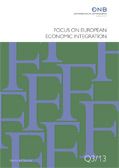Focus on European Economic Integration Q1/17
 OeNB
OeNB
- Erschienen:
- März 2017.
 OeNB
OeNB
Call for entries: Olga Radzyner Award 2017 (PDF, 51 kB) Focus on European Economic Integration Q1/17 en 03.03.2017, 00:00:00
Call for applications: Visiting Research Program (PDF, 50 kB) Focus on European Economic Integration Q1/17 en 03.03.2017, 00:00:00
How does foreign currency debt relief affect households’ loan demand? Evidence from the OeNB Euro Survey in CESEE (PDF, 334 kB) Beckmann. Beckmann – Focus on European Economic Integration Q1/17 Many Central, Eastern and Southeastern European (CESEE) countries have implemented or are discussing measures to alleviate the debt burden of households with foreign currency loans, in particular Swiss franc loans, such as converting these loans at historical exchange rates. This paper presents evidence from the OeNB Euro Survey indicating whether households are aware of government efforts to help borrowers and shows that awareness of current government measures is positively and significantly correlated with expectations of future government action for debt relief. We find that expectations of debt relief have no effect on loan demand in general but positively and significantly increase demand for foreign currency loans. en usehold borrowing, debt relief, moral hazard, foreign currency loans, emerging economies G18, D12, D84, F34 03.03.2017, 00:00:00
How do resource-driven economies cope with the oil price slump? A comparative survey of ten major oil-exporting countries (PDF, 313 kB) Barisitz, Breitenfellner. The oil price slump of about 50% since 2014 has had a detrimental effect on oil-exporting emerging market economies (EMEs), potentially threatening to trigger social unrest in countries that had benefited from the oil price boom for more than a decade. We provide a first descriptive account of the policy reactions of central banks and governments of eight important oil-exporting EMEs and compare them with those of two oil-exporting advanced economies, allowing us to distinguish three patterns: One group of countries has so far successfully defended its exchange rate peg to the U.S. dollar, the reference invoicing currency (Saudi Arabia and the United Arab Emirates). A second group gave up resistance to mounting market pressures and carried out step devaluations or switched to a floating exchange rate (Russia, Kazakhstan, Azerbaijan, Nigeria and Angola). A third group of countries continued to let their currencies float (Mexico, Canada and Norway), with the stable long-term relationship between the exchange rate and commodity export prices qualifying these currencies as “commodity currencies.” We conclude that EMEs featuring peg-like regimes and saddled with limited structural diversification, modest fiscal and external buffers as well as weak institutional conditions for capital controls are unlikely to be able to uphold their exchange rate choices if they suffer a major and sustained adverse terms-of-trade shock, and should opt for flexibility sooner rather than later. While declining oil prices may imply a degree of passive diversification, a proactive long-term strategy to develop a more diversified economic structure in good times could at least partly reduce the need for buffers. de oil price shock, emerging market economies, oil-exporting countries, oil currencies, Q43, O13 03.03.2017, 00:00:00
How would a fiscal shock in Germany affect other European countries? Evidence from a Bayesian GVAR model with sign restrictions (PDF, 390 kB) Eller, Feldkircher, Huber. In this paper we analyze the international effects of a fiscal policy shock in Germany on other European countries. To that end we use a flexible version of a Bayesian global vector autoregression (GVAR) model and a dataset with broad country coverage comprising a wide range of macroeconomic and financial variables. Our results suggest a comparatively strong response in a majority of European economies to such a shock. In particular, we provide evidence that a deficit-financed expansionary government spending shock in Germany generates long-lasting positive cross-border output spillovers. In the case of the euro area periphery and Central, Eastern and Southeastern (CESEE) economies, these effects may be transmitted via the financial channel since financial variables such as equity prices and private sector credit significantly increase in response to the assumed fiscal shock in Germany. Upward effects on consumer prices, by contrast, are limited to core euro area countries. When looking at the effects of an expansionary tax cut shock instead of those of a spending-driven fiscal shock, we identify cross-border output spillovers of a similar magnitude but with a lower degree of persistence; in the case of CESEE economies, these results are also characterized by more estimation uncertainty. Finally, we also provide evidence for considerable cross-country heterogeneity in fiscal spillovers; for instance within CESEE, output responses to a fiscal shock in Germany are strongest in Croatia, Hungary and Slovenia. en transmission of external shocks; cross-border spillovers; fiscal policy; global vector autoregression; sign restrictions; Central, Eastern and Southeastern Europe; euro area; Germany C30, C54, E62, F41, H60, P2 03.03.2017, 00:00:00
CESEE-related abstracts from other OeNB publications (PDF, 71 kB) Focus on European Economic Integration Q1/1 de 03.03.2017, 00:00:00
Completing Economic and Monetary Union Forum hosted by the OeNB in Vienna on November 24 and 25, 2016 (PDF, 204 kB) Breitenfellner, Nader-Uher, Messner – Focus on European Economic Integration Q1/17 en 03.03.2017, 00:00:00
21st Global Economy Lecture: “How should Europe meet the duty of rescue towards the displaced and the poor?” (PDF, 64 kB) Messner – Focus on European Economic Integration Q1/17 en 03.03.2017, 00:00:00
Olga Radzyner Award winners 2016 (PDF, 58 kB) Eller – Focus on European Economic Integration Q1/17 en 03.03.2017, 00:00:00
Notes (PDF, 111 kB) de 03.03.2017, 00:00:00